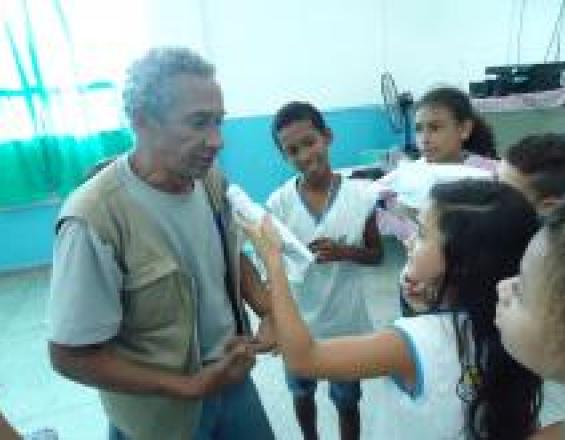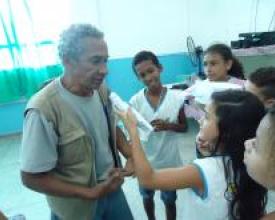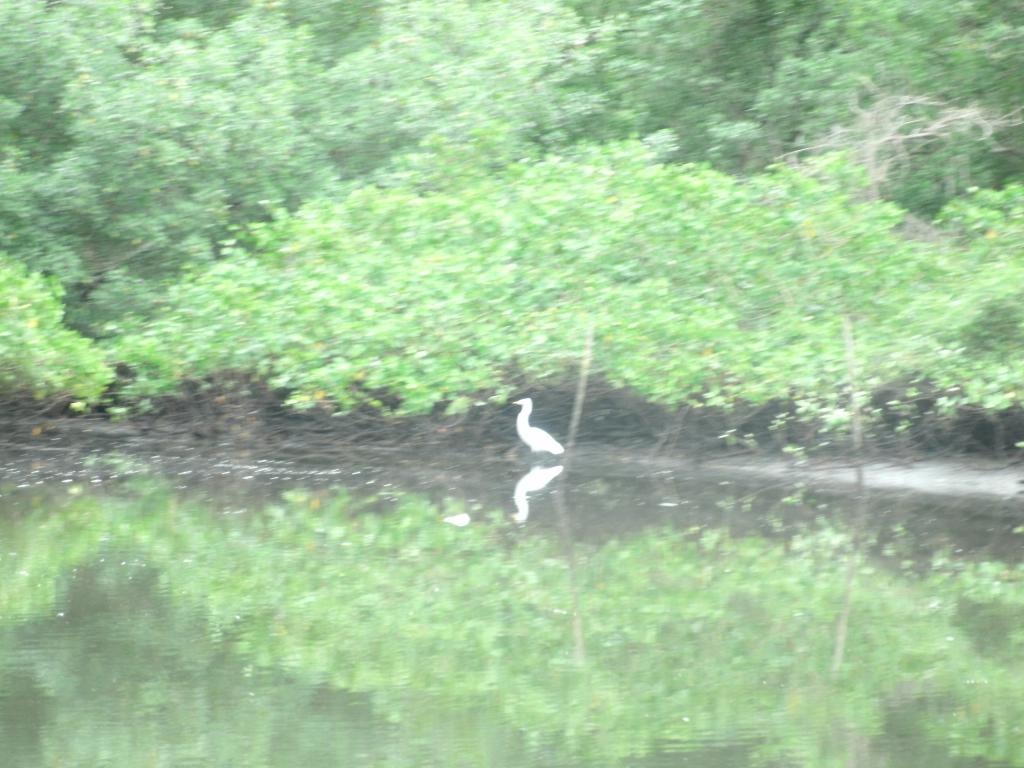Travail bénévole dans le cadre de différentes activités d'éducation à l'environnement

Le volontariat a été un bon moyen de constituer des équipes et surtout d'impliquer la population locale dans les efforts environnementaux dans deux zones protégées. Nous avons profité de la nécessité pour les étudiants de collèges et d'universités d'effectuer des activités extrascolaires pour compléter leurs cours afin d'attirer des volontaires. Nous avons également développé un partenariat avec une ONG pour recruter des volontaires dans les centres urbains afin de mener des activités spécifiques. Les volontaires sont désignés pour des projets dans les écoles, les communautés et les sièges.
Contexte
Défis à relever
Manque de sensibilisation, budget et personnel limités Ces zones protégées fédérales sont situées dans la région métropolitaine de Rio de Janeiro, qui compte 12 millions d'habitants. La protection des mangroves et des eaux de la baie de Guanabara est donc une tâche difficile, et le personnel et le budget gouvernemental sont limités. Les connaissances locales et la prise de conscience de l'importance de la zone ne sont pas très répandues. En outre, le bénévolat n'est pas très répandu au Brésil.
Emplacement
Traiter
Résumé du processus
Le Brésil est un pays qui a récemment atteint un niveau de revenu moyen. Le budget public consacré à la mise en œuvre des zones protégées est encore faible, mais grâce à l'augmentation des possibilités d'éducation, la culture du volontariat est devenue plus courante. Un cadre juridique pour le volontariat a été mis en place au cours des deux dernières décennies. L'Institut de conservation de la biodiversité Chico Mendes (ICMBio) a lancé son programme de volontariat en 2009, reconnaissant l'importance du travail bénévole. Cependant, le siège de la zone protégée étant situé dans une région à faible revenu et loin des centres urbains, il est difficile d'attirer des personnes pour le volontariat. Ainsi, saisissant l'opportunité que de nombreux collèges et universités demandent à leurs étudiants de faire des activités extrascolaires pour obtenir leur diplôme, nous avons reçu de nombreux étudiants pour développer des activités de bénévolat qualifiées. Ces activités sont un moyen important de faire connaître l'importance de cette zone protégée et de ses écosystèmes. En outre, elles constituent un canal de communication avec la population locale. Un autre élément contributif est la promotion de partenariats avec des ONG pour organiser et financer des activités pour les volontaires urbains. Grâce à cette initiative, nous pouvons non seulement sensibiliser la population, mais aussi attirer des bénévoles compétents.
Blocs de construction
Institutionnalisation du programme de volontariat
Facteurs favorables
Leçon apprise
Ressources
Attirer les étudiants des universités et des collèges
Facteurs favorables
Leçon apprise
Ressources
Projets dans les écoles
Facteurs favorables
Leçon apprise
Projets dans les communautés locales
Facteurs favorables
Leçon apprise
Manifestations ouvertes à tous avec des activités environnementales
Facteurs favorables
Leçon apprise
Création de matériel et promotion des moyens de communication
Facteurs favorables
Leçon apprise
Impacts
Différentes actions impliquant des volontaires ont eu des effets importants : de meilleures relations avec la population locale et une plus grande sensibilisation du public à l'importance de ces zones protégées pour la conservation des mangroves. Ces impacts sont mis en évidence par certains résultats du projet, tels que - Contact avec 25 écoles autour de ces zones protégées, comprenant environ 4 000 élèves de la maternelle au lycée. L'un des résultats de ces activités scolaires a été l'augmentation de l'estime de soi et la reconnaissance de l'importance des mangroves parmi les enfants et les adolescents locaux qui avaient tendance à considérer les mangroves comme sales et puantes. - Les volontaires ont également appris aux élèves à écrire et à développer leurs propres projets, ce qui a eu pour effet d'éveiller la citoyenneté des jeunes et d'améliorer la qualité de vie de la population locale. - Un autre résultat a été l'engagement de la population urbaine par le biais d'une journée de travail sur la nature impliquant la récupération des forêts des berges. Outre la sensibilisation à l'environnement, ce projet a eu pour effet d'attirer des professionnels qualifiés pour développer volontairement d'autres projets pour lesquels il n'y avait pas de budget public.
Bénéficiaires
nature, élèves des écoles locales, bénévoles, population locale, enseignants
Histoire
Élevée dans une famille rurale, Maria Lidia Novaes Correa a dû commencer à travailler très tôt. Pour subvenir aux besoins de sa famille, elle a travaillé pendant plus de 15 ans comme cuisinière dans des restaurants. Lorsque ses enfants ont grandi et que ses besoins financiers ont diminué, elle a décidé de réaliser ses rêves : étudier et travailler dans le domaine de l'environnement. Elle a terminé ses études secondaires à l'âge de 46 ans et a ensuite suivi plusieurs cours techniques. Sept ans plus tard, elle a été admise dans deux universités, dans des cours de premier cycle en gestion de l'environnement et en biologie. À 54 ans, elle a entendu parler du programme de volontariat de l'Institut de conservation de la biodiversité Chico Mendes (ICMBio) et s'est intéressée au volontariat dans la zone environnementale protégée de Guapi-Mirim et à la station écologique de Guanabara parce qu'elle avait passé son enfance dans la région. Après avoir mis deux heures pour arriver au bureau, elle a travaillé comme bénévole dans ces zones protégées pendant environ 18 mois, une fois par semaine, en entretenant les pépinières et en organisant des événements publics. De sa propre initiative, elle a guidé et construit un système de lombricompostage avec l'aide d'un autre volontaire. Depuis lors, toutes les peaux de fruits et de légumes crus provenant des repas des employés et des bénévoles y sont déposées, et l'engrais est utilisé dans le jardin biologique du siège, qui est une attraction pour les visiteurs. L'un des employés chargés de l'entretien a appris l'importance du système et la manière de le mettre en œuvre, et a donné des conférences sur le sujet. Il y a quelques mois, M. Correa a été invité par une école primaire de la région à aménager un jardin avec les élèves. Cette école, l'une de celles où des bénévoles gèrent le projet "Goes to School" de la zone environnementale protégée de Guapi-Mirim, est située dans une région très pauvre. De nombreux élèves ont une structure familiale fragile. Maria Lidia raconte que lorsqu'elle est arrivée, de nombreux élèves fuyaient l'école pendant leur temps libre, et qu'aujourd'hui, la majorité d'entre eux est très impliquée dans les activités de jardinage. Bien que Maria Lidia ne puisse plus venir chaque semaine, nous l'invitons souvent à collaborer à d'autres projets. Selon elle, "c'était une excellente occasion pour moi d'en apprendre davantage sur les zones protégées et sur la manière dont elles sont gérées. J'ai également réalisé que mes connaissances étaient importantes pour les autres et pour l'environnement. L'expérience du volontariat a également été utile pour mes études".




